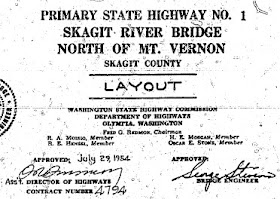Above you are looking at a bird's eye view of the Skagit River I-5 Bridge soon after it opened for traffic in the mid 1960s.
Yesterday I blogged that the Federal Highway Administration National Bridge Inventory Database is erroneous regarding the date that the I-5 Skagit River Bridge was built, with that database saying the year was 1955, a year before the construction of the Interstate Freeway System was authorized by the Federal Aid Highway Act of 1956.
Construction of Interstate 5 in Washington did not begin until the early 1960s.
Yesterday someone named Anonymous made a post comment regarding the erroneous date...
Anonymous has left a new comment on your post "The Collapsed I-5 Skagit River Bridge Was Built in the 1960s not 1955":
The huge flood of 1955 occurred on November 4th, absent a freeway bridge. Maybe it was constructed in December of 1955? Odd time of year to build a bridge, however the Skagit Herald is rarely wrong, nor is our nation's databases.
My nephews, Jason and Joey, have been seeking proof regarding as to when the Skagit River I-5 Bridge was actually built, ever since it collapsed into the river and news reports began erroneously reporting the bridge was born in 1955, a year after Jason and Joey's dad was born.
This morning, at 5am, Jason made his way to the south end of the collapsed bridge, determined to get a photo of the plaque attached to the bridge which lists its date of birth. Jason made it past the blocking barriers, but was thwarted by a pair of Washington State Patrolmen who would allow Jason to go no further.
Jason has enlisted the help of a law enforcement friend of his to try and get a picture.
This morning Jason told me that he has learned that it was the Highway 99 Skagit River Bridge which was built in 1955. You can see the Highway 99 Bridge in the photo above, in the background behind the I-5 Bridge. The Highway 99 Bridge, apparently built in 1955, was replaced in 2004.
Somehow, perhaps when transcribing print data to digital form, the date of the building of the Skagit River I-5 Bridge was entered as 1955.
Would not one think that this is fairly easy to verify as erroneous? As in Interstate 5 was not under construction in 1955, so how could an Interstate Bridge across the Skagit River be built in 1955?
This morning Jason emailed me the two photos you see above. In the first photo you can clearly see that the two bridges are in an area of farmland, for the most part. Does it really make any sense to anyone that the I-5 Bridge sat constructed in 1955, a Bridge to Nowhere, waiting a decade for a road to connect to it?
It is interesting to look at these photos and ponder the huge changes that came to the Skagit Valley after the arrival of Interstate 5.
In the second photo we are in Mount Vernon looking north. The College Way exchange is in the foreground. The now collapsed I-5 Skagit River Bridge is near the top of the picture.
I believe the above photos were likely taken in the mid 1960s. If you were to look at the same view as these photos today, in 2013, you would see a lot of buildings and a lot of asphalt.
On the left (west) side of the freeway in Mount Vernon you'd see a Walmart Supercenter along with a lot of other stores and restaurants. After I-5 opened, by the 1970s, on the right (east) side of I-5, in Mount Vernon, you would find a mall on both sides of College Way, replacing what had been tulip and strawberry fields.
The Mount Vernon malls have been long gone, torn down and replaced by more stores, including what at one point in time was the biggest Safeway in the world. or west of the Mississippi or something.
The Burlington side of the river saw the most drastic changes after I-5 came to town.
In 2013, in the view in the second photo of the Burlington side of the Skagit River, you would see the Cascade Mall, a complex of auto dealers called I-5 Auto World, a Costco, a big outlet center, a Fred Meyer, Target (is K-Mart still open in Burlington?), Haggen, many of the usual chain restaurants and fast food joints and a Krispy Kreme, though the donut maker may be gone.
I think I heard Krispy Kreme did not go over well in the valley.
Jason told me this morning that a lot of the Skagit Valley locals he has asked about it are as perplexed as he regarding the erroneous birth date of the Skagit River I-5 Bridge in the National Bridge Inventory Database.
I suspect this error will be corrected. Someday. Maybe.





































